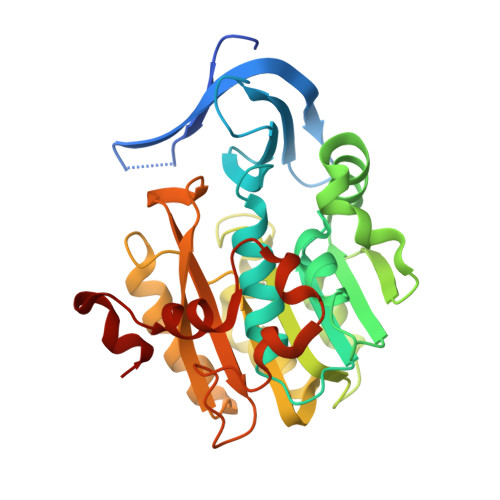Structural insights into the novel inhibition mechanism of Trypanosoma cruzi spermidine synthase.
Amano, Y., Namatame, I., Tateishi, Y., Honboh, K., Tanabe, E., Niimi, T., Sakashita, H.(2015) Acta Crystallogr D Biol Crystallogr 71: 1879-1889
- PubMed: 26327378
- DOI: https://doi.org/10.1107/S1399004715013048
- Primary Citation of Related Structures:
4YUV, 4YUW, 4YUX, 4YUY, 4YUZ, 4YV0, 4YV1, 4YV2 - PubMed Abstract:
Trypanosoma cruzi causes Chagas disease, a severe disease affecting 8-10 million people in Latin America. While nifurtimox and benznidazole are used to treat this disease, their efficacy is limited and adverse effects are observed. New therapeutic targets and novel drugs are therefore urgently required. Enzymes in the polyamine-trypanothione pathway are promising targets for the treatment of Chagas disease. Spermidine synthase is a key enzyme in this pathway that catalyzes the transfer of an aminopropyl group from decarboxylated S-adenosylmethionine (dcSAM) to putrescine. Fragment-based drug discovery was therefore conducted to identify novel, potent inhibitors of spermidine synthase from T. cruzi (TcSpdSyn). Here, crystal structures of TcSpdSyn in complex with dcSAM, trans-4-methylcyclohexylamine and hit compounds from fragment screening are reported. The structure of dcSAM complexed with TcSpdSyn indicates that dcSAM stabilizes the conformation of the `gatekeeping' loop to form the putrescine-binding pocket. The structures of fragments bound to TcSpdSyn revealed two fragment-binding sites: the putrescine-binding pocket and the dimer interface. The putrescine-binding pocket was extended by an induced-fit mechanism. The crystal structures indicate that the conformation of the dimer interface is required to stabilize the gatekeeping loop and that fragments binding to this interface inhibit TcSpdSyn by disrupting its conformation. These results suggest that utilizing the dynamic structural changes in TcSpdSyn that occur upon inhibitor binding will facilitate the development of more selective and potent inhibitors.
Organizational Affiliation:
Drug Discovery Research, Astellas Pharma Inc., 21 Miyukigaoka, Tsukuba, Ibaraki 305-8585, Japan.















